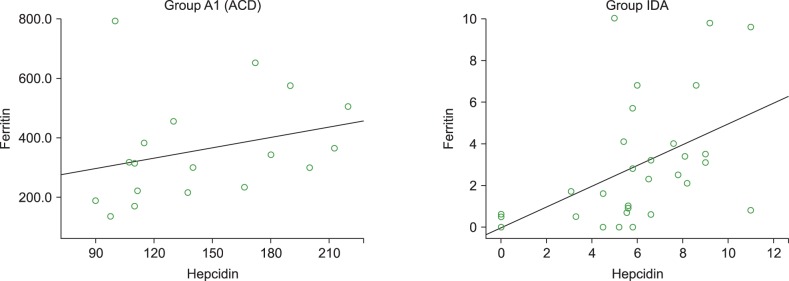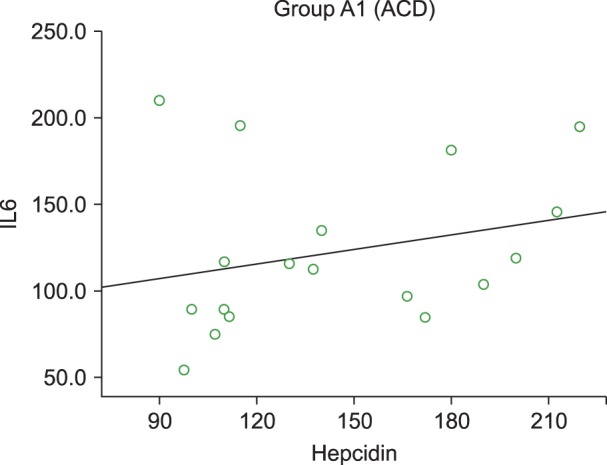Blood Res.
2017 Sep;52(3):212-217. 10.5045/br.2017.52.3.212.
Hepcidin and iron parameters in children with anemia of chronic disease and iron deficiency anemia
- Affiliations
-
- 1Department of Pathology, Lady Hardinge Medical College, New Delhi, India. dr.gunjan2003@gmail.com
- 2Department of Paediatrics, Lady Hardinge Medical College, New Delhi, India.
- KMID: 2390984
- DOI: http://doi.org/10.5045/br.2017.52.3.212
Abstract
- BACKGROUND
Anemia of chronic disease (ACD) and iron deficiency anemia (IDA) are the two most prevalent forms of anemia having interrelated characteristics. Hepcidin, a newly introduced biomarker for assessment of iron status, is a homeostatic regulator of iron metabolism. We investigated the role of hepcidin and other conventional iron parameters to assess iron status among children with ACD and IDA. We also identified children with ACD who developed iron deficiency (ID).
METHODS
The study was undertaken in anemic children with 30 cases each of ACD and IDA along with 30 age and sex-matched controls. The ACD cases were subdivided into pure ACD and ACD with coexistent ID. All cases were subjected to following tests: complete blood count with peripheral smear, serum C-reactive protein, serum interleukin-6, iron studies, serum soluble transferrin receptor (sTfR), and serum hepcidin.
RESULTS
The mean serum hepcidin concentration was significantly increased in pure ACD patients (143.85±42.76 ng/mL) as compared to those in IDA patients (6.01±2.83 ng/mL, P < 0.001) and controls (24.96±9.09 ng/mL, P <0.001). Also, compared to pure ACD patients [normal sTfR levels (<3 µg/mL)], the serum hepcidin concentration was reduced significantly in ACD patients with ID [high sTfR levels (≥3 µg/mL)] with a mean of 10.0±2.97 ng/mL.
CONCLUSION
Hepcidin measurement can provide a useful tool for differentiating ACD from IDA and also help to identify an iron deficiency in ACD patients. This might aid in the appropriate selection of therapy for these patients.
MeSH Terms
Figure
Reference
-
1. Theurl I, Aigner E, Theurl M, et al. Regulation of iron homeostasis in anemia of chronic disease and iron deficiency anemia: diagnostic and therapeutic implications. Blood. 2009; 113:5277–5286. PMID: 19293425.
Article2. Kemna EH, Tjalsma H, Willems HL, Swinkels DW. Hepcidin: from discovery to differential diagnosis. Haematologica. 2008; 93:90–97. PMID: 18166790.
Article3. Krause A, Neitz S, Mägert HJ, et al. LEAP-1, a novel highly disulfide-bonded human peptide, exhibits antimicrobial activity. FEBS Lett. 2000; 480:147–150. PMID: 11034317.
Article4. Park CH, Valore EV, Waring AJ, Ganz T. Hepcidin, a urinary antimicrobial peptide synthesized in the liver. J Biol Chem. 2001; 276:7806–7810. PMID: 11113131.
Article5. D'Angelo G. Role of hepcidin in the pathophysiology and diagnosis of anemia. Blood Res. 2013; 48:10–15. PMID: 23589789.6. Nemeth E, Rivera S, Gabayan V, et al. IL-6 mediates hypoferremia of inflammation by inducing the synthesis of the iron regulatory hormone hepcidin. J Clin Invest. 2004; 113:1271–1276. PMID: 15124018.
Article7. Wrighting DM, Andrews NC. Interleukin-6 induces hepcidin expression through STAT3. Blood. 2006; 108:3204–3209. PMID: 16835372.
Article8. World Health Organization. Iron deficiency anaemia assessment, prevention, and control: A guide for programme managers. Geneva, Switzerland: World Health Organization;2001.9. Jain S, Narayan S, Chandra J, Sharma S, Jain S, Malhan P. Evaluation of serum transferrin receptor and sTfR ferritin indices in diagnosing and differentiating iron deficiency anemia from anemia of chronic disease. Indian J Pediatr. 2010; 77:179–183. PMID: 20091370.
Article10. Marković M, Majkić-Singh N, Subota V. Usefulness of soluble transferrin receptor and ferritin in iron deficiency and chronic disease. Scand J Clin Lab Invest. 2005; 65:571–576. PMID: 16271988.
Article11. Demirag MD, Haznedaroglu S, Sancak B, et al. Circulating hepcidin in the crossroads of anemia and inflammation associated with rheumatoid arthritis. Intern Med. 2009; 48:421–426. PMID: 19293540.
Article12. van Santen S, van Dongen-Lases EC, de Vegt F, et al. Hepcidin and hemoglobin content parameters in the diagnosis of iron deficiency in rheumatoid arthritis patients with anemia. Arthritis Rheum. 2011; 63:3672–3680. PMID: 22127690.
Article13. Geerts I, Vermeersch P, Joosten E. Evaluation of the first commercial hepcidin ELISA for the differential diagnosis of anemia of chronic disease and iron deficiency anemia in hospitalized geriatric patients. ISRN Hematol. 2012; 2012:567491. PMID: 22461996.
Article14. Casals-Pascual C, Huang H, Lakhal-Littleton S, et al. Hepcidin demonstrates a biphasic association with anemia in acute Plasmodium falciparum malaria. Haematologica. 2012; 97:1695–1698. PMID: 22689680.
Article15. Suega K. Role of hepcidin in mechanism of anemia chronic disease patients. Bali Med J. 2014; 3:89–96.16. Choi HS, Song SH, Lee JH, Kim HJ, Yang HR. Serum hepcidin levels and iron parameters in children with iron deficiency. Korean J Hematol. 2012; 47:286–292. PMID: 23320008.
Article17. Elgari MM, Al-Oufi F, alSalmi M, Kurdi M, Ibrahim NA, Elmugadam A. Role of serum hepcidin levels in the diagnosis of iron deficiency anemia in children in Saudi Arabia. Am J Res Commun. 2015; 3:24–30.18. Pasricha SR, McQuilten Z, Westerman M, et al. Serum hepcidin as a diagnostic test of iron deficiency in premenopausal female blood donors. Haematologica. 2011; 96:1099–1105. PMID: 21508121.
Article19. Girelli D, Nemeth E, Swinkels DW. Hepcidin in the diagnosis of iron disorders. Blood. 2016; 127:2809–2813. PMID: 27044621.
Article20. Song SN, Tomosugi N, Kawabata H, Ishikawa T, Nishikawa T, Yoshizaki K. Down-regulation of hepcidin resulting from long-term treatment with an anti-IL-6 receptor antibody (tocilizumab) improves anemia of inflammation in multicentric Castleman disease. Blood. 2010; 116:3627–3634. PMID: 20644113.
Article
- Full Text Links
- Actions
-
Cited
- CITED
-
- Close
- Share
- Similar articles
-
- Understanding and exploiting hepcidin as an indicator of anemia due to chronic kidney disease
- Serum Pro-hepcidin as an Predictor of Iron Deficiency in Anemic Patients
- Intravenous Iron Sucrose for Three Children with Iron Deficiency Anemia Failing to Respond to Oral Iron Therapy
- Molecular perspective of iron uptake, related diseases, and treatments
- Iron Deficiency Anemia in Children and Adolescents



